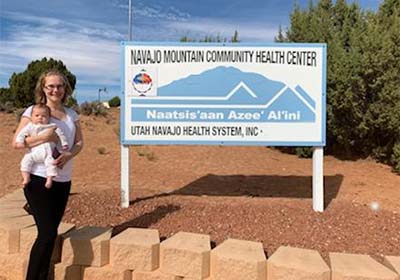
Author: Doug Dollemore

Traditionally, the bond between mother and child was the most important relationship in Navajo culture. And that bond began with an intimate and tender act: breastfeeding.
“Our people view breast milk as a gift from the deities to help us survive,” says Amanda Singer, executive director of the Navajo Nation Breastfeeding Coalition. “Breastfeeding allows a mother to pass her wisdom and heritage on to her child.”
But like many other cultures, breastfeeding declined in the Navajo Nation in the 20th century as infant formula became more available and breastfeeding itself was increasingly viewed as a primitive practice. By the early 1970s, only 22% of American mothers breastfed, and most only did so for the first few weeks of life.
However, since then there has been a revival, to the point that 84% of newborns in the United States are breastfed. Despite this, only 58% of those infants are still being exclusively breastfed at six months, as recommended by the American Academy of Pediatrics.
Compared to bottle fed infants, breastfed babies have stronger immune systems and are less prone to ear infections, digestive problems, diabetes, and obesity, as well as colds and other respiratory illnesses. And for women, breastfeeding speeds weight loss after birth, stimulates the uterus to contract and return to its normal size, and lessens the risk of postpartum depression.
Despite these many benefits, exclusive breastfeeding for six months isn’t easy for many women to do, according to Laura Brown, MD, an assistant professor of pediatrics at University of Utah Health. This is particularly true for those living in underserved Navajo communities, such as the predominately Navajo residents of rural San Juan County, Utah.
In a new study published in Maternal and Child Health Journal, Brown found, despite their best intentions, less than 40% of women in this county in southeastern Utah were exclusively breastfeeding their babies for more than two months. Yet breastfeeding, Brown says, could improve health outcomes for these children later in life.
“The Navajo Nation is at higher risk than most communities in the United States for preventable adverse health outcomes, specifically obesity and diabetes,” Brown says. “Breastfeeding is known to decrease the incidence of both of those conditions.”
In addition to typical barriers to breastfeeding, such as latch difficulties and maternal pain, the researchers found that a lack of accessibility to lactation counseling deterred Navajo women from optimal breastfeeding practices. In addition, negative attitudes about breastfeeding expressed by the children’s fathers also contributed to its disuse.
“Many of these fathers just don’t know how important breastfeeding is to both mother and child,” Brown says. “If they see their partner struggling to breastfeed and the baby is crying all night, and they have to go to work in the morning, giving the baby some formula might seem like the most reasonable thing to do.”
The researchers analyzed 135 medical records for infants born in San Juan County in 2018. These records indicated that about 60% of these babies received some infant formula in their first few days of life, a practice shown to decrease breastfeeding duration.
They also surveyed 85 new mothers, 72% of whom identified as Navajo. Of those, 89% initiated breastfeeding while in the hospital. However, only 38% of their infants were still exclusively breastfeeding at age two months.
At the time of the study, formal lactation support wasn’t available in San Juan County, nor were most doctors and nurses trained to provide breastfeeding support. As a result of Brown’s study and associated grant funding, rural Navajo Nation now has two Certified Lactation Educator Counselors (one of whom is a Navajo peer counselor). More than 50 regional healthcare providers have also received breastfeeding support training via telehealth or webinar. Telehealth appointments for breastfeeding women in remote areas are also now available. Brown and her colleagues are currently evaluating the effects of these changes.
“Our initial observations suggest that some actionable strategies for evidence-based and culturally sensitive interventions could help improve breastfeeding duration and exclusivity,” Brown says.